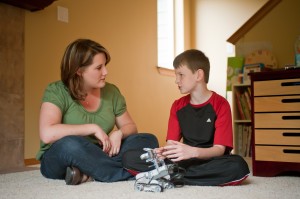Therapies & programs provided by A Speech Path include, but are not limited to:
- Speech Disorders: Articulation, Phonological Processing & Childhood Apraxia of Speech
- Receptive & Expressive Language
- Literacy
- Autism Spectrum Disorders (Speech and language)
Please Note: If you have concerns other than those listed, please contact me regarding the appropriateness of my services. If A Speech Path is not the most suitable placement for your child, I will gladly discuss other options with your pediatrician and/or provide a recommendation for other providers.
For resources and information on typical communication development and milestones, please visit:
Speech is movement made audible – R.H. Stetson
Articulation refers to the motor movement required to produce speech sounds—a highly refined and precise coordination of movements made by the tongue, jaw, and lips. Speech sound acquisition is developmental in nature, and all children have trouble making particular sounds at some point in their development. However, some children have lingering errors and benefit from intervention. An articulation disorder occurs when a child omits, substitutes, or distorts a sound within his speech beyond the age of expected development.
Phonological processing refers to the predictable patterns and processing of speech sounds. Children often use a phonological process that creates a predictable substitution pattern that simplifies the movement required by the tongue and jaw—for example, using a /t/ or /d/ for a /k/ or /g/ sound (‘tar’ for ‘car’ or ‘doe’ for ‘go’). Because the child’s speech errors follow a pattern, familiar listeners often “break the code” and understand more than unfamiliar listeners do. Many children demonstrate phonological errors in their developmental progression; however, if errors continue beyond the age of expected resolution, intervention may be warranted.
Assessment & Intervention
I use a variety of formal and informal measures to determine whether an articulation disorder is present. Assessment typically starts with an informal observation of conversational speech to determine the overall impact of the errors on communication abilities, followed by subsequent tasks targeting sounds in a more isolated context. Finally I assess stimulability – which determines the child’s ability to produce the erred sounds given a variety of instruction or cues. Combined, the results of these assessments indicate the need and/or readiness for therapy.
If intervention is recommended, I will individually design a program to meet your child’s needs. This varies from child to child; we all learn best when information is personally meaningful to us, so activities will be based on your child’s specific interests and fine-tuned as therapy progresses. Every effort will be made to create a therapy process that is interesting and enjoyable – your child’s engagement is the key to success!
Signs & Symptoms:
- Others have difficulty understanding your child
- Child expresses frustration at not being understood by others
- Child makes errors, substitutions or distorts sounds
- Child demonstrates decreased precision of speech
- Child limits communication for fear of not being understood
Additional Resources & Information:
The limits of my language mean the limits of my world. – Ludwig Wittgenstein (1889 – 1951)
Receptive language—the understanding of language—is the foundation for our ability to follow directions, learn, and understand what a communication partner is expressing in order to respond appropriately. However, as there are many co-occurring difficulties (such as attention and memory) that impact receptive language, a thorough evaluation is important in determining whether or not difficulties are language-based.
Expressive language refers to the ability to communicate wants, needs, and thoughts to engage with others, and includes the specific components of language, such as sentence order and grammar use, as well as overall communicative effectiveness (for example, the variety and use of vocabulary).
Children can present with a delay in one or both of these areas. In older children, difficulties can greatly impact academic success as it relates to reading, writing, and engaging with peers.
Assessment & Intervention
The process for evaluating language abilities varies with the child’s age and symptoms. I use a combination of formal and informal measures to assess and determine areas of strength in relation to areas of challenge.
If a delay is determined and intervention is recommended, a concerted and ongoing effort will be made to ensure language learning is meaningful. Language does not stop once a therapy session is over; I believe strongly in collaboration with the family, empowering you through education to implement language strategies in your daily and routine interactions. Your involvement is a vital and invaluable part of your child’s progress.
For the older children, therapy may also incorporate their academic work. As we all learn differently (e.g., a visual learner vs. an auditory learner), the child’s learning strengths and preferences are taken into consideration and utilized to maximize the outcome.
You can know the name of a bird in all the languages of the world, but when you’re finished, you’ll know absolutely nothing whatever about the bird… So let’s look at the bird and see what it’s doing — that’s what counts. I learned very early the difference between knowing the name of something and knowing something. – Richard Feynman (1918 – 1988)
Signs & Symptoms
Signs and symptoms of a language-based disorder are vast in number and greatly depend on the child’s age. Parents are acutely aware of their children’s development and are constantly (even if subconsciously) mentally comparing their child’s development to other same-age peers. For this reason, parents usually develop concerns before anyone else. You know your child best—if you are concerned that there may be a problem, it is always best to speak with your pediatrician and schedule an evaluation with a speech-language pathologist.
Additional Resources & Information:
Stuttering, or disfluencies, alter the fluidity and flow of speech and can be either developmental in nature or persistent through life.
Characteristics of stuttering vary with severity. Primary characteristics may include word repetitions (e.g., “what-what is that?”), syllable repetitions (e.g., “wa-wa is that?”), sound prolongations (e.g., “ssssssssome more, please”) and blocks (this often looks like a word is stuck). Secondary characteristics during moments of stuttering may include facial grimaces, unusual hand or body movements, diverted eye contact, or an increased rate of speech.
Assessment & Intervention:
Assessment looks at stuttering behaviors in a variety of contexts, measuring the number of moments stuttered to achieve a percentage of stuttered speech. Additional considerations include age, gender, when the stuttering began, family history, and the impact of stuttering in daily interactions. If intervention is appropriate, the therapy approach will depend on the type of stuttering and client age; parents may or may not be an integral part of the therapy process.
Signs & Symptoms:
- Repeats parts of words (ca-ca-cat)
- Repeats whole words (my-my-my-game)
- Repeats phrases
- Blocks (often looks like words get stuck)
- Prolongs certain sounds
- Demonstrates tension in their face or body
- Demonstrates excessive or unusual hand or body movements
- Avoids eye contact
Additional Resources & Information:
If the English language made any sense, a catastrophe would be an apostrophe with fur.
– Doug Larson
Literacy refers to the ability to read and use written language. Verbal language is the foundation of literacy, so if there are underlying language delays a child’s literacy development may also be impacted.
Reading incorporates a number of complex processes: sound awareness, decoding (sounding out a word), sight word knowledge (memorized words), comprehension, and reading fluency (how efficient a child’s reading is in terms of accuracy and speed). Written language requires all the components of reading to promote spelling and relies heavily upon verbal language skills as they relate to putting ideas together, sequencing them appropriately, and elaboration. When children struggle with any of these areas, their academic confidence is often greatly diminished.
Assessment & Intervention
Assessment utilizes a combination of formal testing and informal assessment, as well as analysis of a student’s schoolwork (particularly for difficulties with writing and spelling). Intervention utilizes a child’s language and literacy strengths to promote the development of skills in aspects that are more challenging.
Additional Resources & Information:
Autism Spectrum Disorder (ASD) is a neurological impairment characterized by three areas of atypical development, including delayed social and communication development, and the presence of restrictive, repetitive patterns of behavior.
Assessment & Intervention
A speech-language pathologist (SLP) cannot make a diagnosis of autism; however, an SLP’s observations can provide necessary information within a multi-disciplinary team to establish a diagnosis. Additionally, an SLP is an integral part of the therapy team, targeting both communication and social language development.
Children with ASD have highly individual needs and treatment significantly varies from one child to the next; however, the use of language is strongly tied to social desires. Because children with ASD have different social communication abilities from those without ASD, therapy frequently targets multiple levels of both social and language communication.
Communication does not stop once a therapy session is over. I believe strongly in empowering your family through education so you can provide increased opportunities for communication in your daily and routine interactions. Additionally, collaboration with other professionals who work with your child is exceptionally important.
True interactivity is not about clicking on icons or downloading files [sic], it’s about encouraging communication. – Edwin Schlossberg
Signs & Symptoms
- Limited babbling or cooing as a baby
- Limited or absence of response to child’s name
- Limited or no eye contact
- Repetitive behaviors, such as lining up objects or spinning a single car wheel repetitively
- Lack of interest in people or peers
- Delayed language abilities
- If older, repeating words or phrases heard from other sources
- If older, repeating all or part of what someone has just said to the child
Additional Resources & Information:





